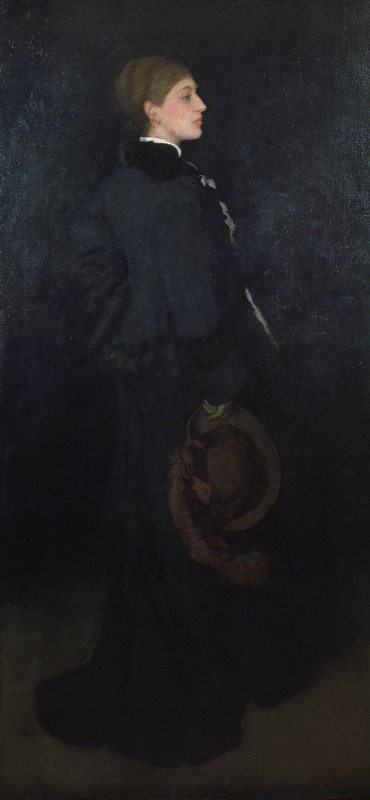Composition
According to Jacques Émile Blanche (1861-1942), Whistler got the idea of the colour scheme from seeing Rosa Corder in a brown dress pass a black door. 1
There are three drawings of Rosa Corder by Whistler, Study of 'Arrangement in Brown and Black: Miss Rosa Corder' [M.0713], Sketch of 'Arrangement in Brown and Black: Portrait of Miss Rosa Corder' [M.0714] and Sketch after the portrait of Rosa Corder [M.0715].
A pencil drawing in the Lucas Collection, Baltimore, shows the skirt hanging almost straight down, the hem curving gently to right.
A pen and wash sketch in the British Museum is similar to the painting except that Corder's head and shoulders are turned a little further away from the spectator, and the skirt trails out to left. Another pen and wash drawing, signed with a butterfly that can be dated about 1883, is in the Art Institute of Chicago and shows the hem of the skirt sweeping out on both sides, yet giving the impression of movement, as if the figure is turning to right. The drawings accentuate the sweeping curves of Rosa's dress and hat. Both of these were probably done after the oil painting.
Technique
Arrangement in Brown and Black: Portrait of Miss Rosa Corder is painted on coarse, slubby canvas. It is, for Whistler, painted quite thickly. The face is highly finished, the hair painted more freely.
Rosa Corder told Graham Robertson she posed 'standing in a doorway with the darkness of a shuttered room beyond her' and she gave about forty 'long sittings, lasting on occasions until she fainted, and at last she refused to go on with them.' 2 Hence some areas, such as the hem of the dress, and the meeting of wall and floor, appear unfinished.
Conservation History
The canvas is lined. It was washed by Whistler – or rather under his supervision – in 1903, which, said the Pennells, 'makes all the difference in the colour, for it was very dirty.' 3 However, Whistler complained to William Stephen Marchant (1868-1925) of Goupil's that their picture restorer, Edwin William Izod (1872-1896) of Izod & Co., Great Portland Street, had not looked after the painting personally and there was some bloom under the varnish. 4
The Frick Collection conservation records note that by 1923 it was already lined, with the edges trimmed, and that bloom and surface dirt were removed; in 1935 the surface was cleaned 1937; there were problems with bloom, which was removed by George L Stour in 1937, but reappeared by 1941. William Suhr removed varnish and applied Talens retouching varnish in 1965, and the painting was cleaned 1970-1972 and again in 1980. It remains a little darkened. Dr Joyce H. Townsend, Tate Britain conservator, noted in 2017 that, in places, the paint had sunk in, and that the picture had an uneven gloss: also that there was some small-scale surface cracking, which suggests megilp or natural resin was used in the paint.
Frame
1879: In March 1879 Whistler urgently ordered a 'large frame' from Henry John Murcott (1835-1910), picture framer, carver and gilder: ' ... can you knock me up a large frame in 10 days - for the Grosvenor? - no matter how roughly - always the same pattern - if so let your man come tomorrow morning by 10 o'clock - and take the measure.' 5 This was either for Arrangement in Brown and Black: Portrait of Miss Rosa Corder [YMSM 203] or Harmony in Yellow and Gold: The Gold Girl - Connie Gilchrist [YMSM 190].
ca 1882: The current Flat Whistler frame has an autograph handwritten label on the verso reading ‘Pink Picture – J Whistler – 13. Tite Street - Chelsea’. Whistler took that studio on 22 March 1881, moved in later that year, and started to paint Harmony in Pink and Grey: Portrait of Lady Meux [YMSM 229], which was first exhibited in 1882. The label suggests that at a later date the frames of Arrangement in Brown and Black: Portrait of Miss Rosa Corder [YMSM 203] and Harmony in Pink and Grey: Portrait of Lady Meux [YMSM 229] were switched. This could have been when both were shown in the 1892 Goupil exhibition. 6
Other labels on the verso confirm that the current frame was on the picture by 1902. The photograph above shows it framed, on exhibition in Boston in 1904.
Notes:
1: Quoted by Pennell 1908 [more] , vol. 1, p. 202.
2: W. G. Robertson 1931 A [more] , pp. 188-91, 194-95.
3: Pennell 1921C [more] , p. 279.
4: Whistler to Canfield, [20 February 1903], GUW #09008; Whistler to W. Marchant, 22 February 1903, GUW #03054; see Simon, Jacob, British picture restorers, 1600-1950, National Portrait Gallery website at http://www.npg.org.uk.
5: [31 March 1879], GUW #04233.
6: Dr Sarah L. Parkerson Day, Report on frames, 2017. See also Parkerson 2007 [more] .
Last updated: 22nd April 2021 by Margaret










